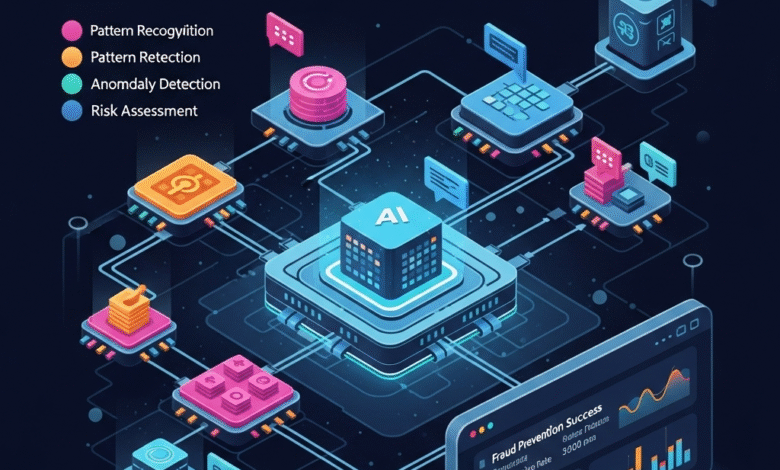Fraud Detection Artificial Intelligence
Fraud Detection Artificial Intelligence : America’s Digital Shield Against Scammers

Fraud Detection Artificial Intelligence
Fraud Detection Artificial Intelligence : America’s Digital Shield Against Scammers
Hey there, security-conscious friend! Whether you’re a small business owner, a banking professional, or just someone tired of resetting compromised passwords, fraud detection artificial intelligence is your silent guardian in the digital trenches. With U.S. businesses losing $8.8 billion to fraud in 2023 (FBI IC3) and synthetic identity scams up 300% since 2020, AI isn’t just helpful—it’s essential armor. Let’s break down how this tech protects your wallet and data.
🚨 Why Traditional Fraud Detection Is Failing America
| Old-School Method | Flaw | AI Solution |
|---|---|---|
| Rule-Based Alerts | Misses novel scams | Learns new fraud patterns |
| Manual Reviews | 72% false positives | 90%+ accuracy with ML |
| Batch Processing | Hours/days delay | Millisecond responses |
| Siloed Data | Limited context | Cross-system behavioral analysis |
Real Pain:
-
⏱️ Zelle users lost $500M to impersonation scams in 2023
-
🏥 Medicare fraud costs taxpayers $60B/year
-
🛒 E-commerce chargebacks jumped 41% post-pandemic
🧠 How Fraud Detection Artificial Intelligence Actually Works
AI fraud tools combine four superpowers:
1. Machine Learning Pattern Recognition
-
What it does: Spots anomalies in transaction data
-
U.S. Application:
-
JPMorgan’s AI reviews 1.5B daily transactions
-
Catches 95% of card-not-present fraud
-
-
Tech Specs:
-
Algorithms: Isolation Forests, XGBoost
-
Features: Device fingerprinting, velocity checks
-
# Simplified fraud scoring model (Python) from sklearn.ensemble import IsolationForest import pandas as pd transactions = pd.read_csv('transaction_data.csv') model = IsolationForest(contamination=0.01) # Flagging top 1% anomalies transactions['fraud_score'] = model.fit_predict(transactions[['amount', 'location', 'time']]) high_risk = transactions[transactions.fraud_score == -1]
2. Natural Language Processing (NLP)
-
What it does: Analyzes text for scam signals
-
Catching:
-
Phishing email language
-
Fake account applications
-
Fraudulent insurance claims
-
-
U.S. Leader: PayPal’s NLP models scan 4M+ customer messages daily
3. Network Analysis
-
What it does: Maps hidden connections between bad actors
-
Exposing:
-
Money mule rings
-
Collusive merchant fraud
-
Synthetic identity factories
-
-
Tool: AWS Fraud Detector’s entity graphing
4. Behavioral Biometrics
-
What it does: Profiles how users interact (keystrokes, mouse movements)
-
Stopping:
-
Account takeovers
-
Remote-access scams
-
Deepfake voice fraud
-
-
Innovator: BioCatch protects 30M+ U.S. banking users
🏦 Industry Spotlights: Fraud Detection Artificial Intelligence in Action
Banking & Fintech
-
Problem: $4.2B lost to check fraud (2023)
-
AI Heroes:
-
Capital One’s deep learning spots altered checks via mobile deposits
-
Stripe Radar uses reinforcement learning to reduce false declines by 40%
-
-
2024 Shift: FedNow real-time payments require AI fraud screening
Healthcare
-
Problem: $300K/minute lost to medical fraud
-
AI Solutions:
-
Optum’s AI audits 5M+ claims/month for phantom billing
-
Epic Systems flags suspicious EMR access patterns
-
-
Savings: Blue Cross NC recovered $210M with AI in 2023
E-Commerce
-
Problem: 42% of merchants face “friendly fraud” chargebacks
-
AI Defenses:
-
Shopify Protect guarantees chargeback protection
-
Amazon’s AI halts 10M+ fake accounts monthly
-
-
Key Tech: Device intelligence + geolocation clustering
📊 The Staggering ROI of Fraud Detection AI
| Metric | Pre-AI | With AI | Impact |
|---|---|---|---|
| Fraud Detection Rate | 45-65% | 92-99% | $2.8M saved/year (avg. bank) |
| False Positives | 70-85% | 15-30% | 5M+ legit transactions approved |
| Investigation Time | 8-12 hours | 8-12 minutes | 97% faster |
| Compliance Costs | $1.2M/year | $380K/year | 68% reduction |
*Source: Aite-Novarica Group 2024 Financial Crime Survey*
🛡️ Implementing Fraud Detection Artificial Intelligence: 5 Steps for U.S. Businesses
-
Assess Your Exposure
-
Audit past fraud incidents
-
Calculate current false positive costs
-
Map high-risk touchpoints (account openings, wire transfers)
-
-
Choose Your Tech Stack
Business Size Recommended Tools SMBs Featurespace, Sift, Kount ($5K-$50K/year) Enterprises FICO Falcon, SAS Fraud Management, Feedzai ($200K-$2M/year) Custom Build Python + Scikit-learn/TensorFlow + AWS Fraud Detector -
Data Integration
-
Connect: Payment processors, CRM, identity systems
-
Prioritize real-time API pipelines
-
Ensure FedRAMP compliance for gov’t contractors
-
-
Human Oversight Design
-
Build alert escalation paths
-
Create hybrid review queues (AI flags → analysts verify)
-
Maintain regulatory audit trails
-
-
Continuous Optimization
-
Retrain models quarterly with new fraud data
-
Join industry threat feeds (FS-ISAC, Merchant Risk Council)
-
Conduct annual adversarial testing
-
🔮 The Future of Fraud Detection Artificial Intelligence
-
Generative AI Countermeasures
-
Detecting deepfakes through micro-expression analysis
-
AI “honeypots” that engage scammers to gather intelligence
-
-
Quantum Machine Learning
-
JPMorgan & MIT testing quantum algorithms to crack encryption-based fraud
-
-
Decentralized AI Networks
-
Bank consortiums sharing threat models without exposing customer data
-
-
Behavioral “Trust Scores”
-
Continuous authentication replacing passwords (pioneered by Apple/Google)
-
“By 2027, 95% of fraud losses will stem from organizations WITHOUT AI defenses.”
– Gartner Financial Crime Prediction
⚠️ Ethical Guardrails: Doing AI Fraud Detection Right
-
Bias Mitigation:
-
Regularly audit models for racial/gender/age discrimination
-
Follow NIST AI Risk Management Framework
-
-
Transparency:
-
Explain why transactions are declined (“We noticed unusual device switching”)
-
-
Privacy Protection:
-
Comply with CCPA/GDPR
-
Use federated learning to keep data local
-
❓ FAQs: Fraud Detection Artificial Intelligence
Q: Can small businesses afford AI fraud tools?
A: Absolutely! Solutions like Square Fraud Protect start at $0.03/transaction – often cheaper than fraud losses.
Q: How fast does fraud detection AI deliver ROI?
A: Most U.S. companies see payback in 3-9 months via reduced losses and manual review costs.
Q: Does AI increase false declines?
A: Initially yes (5-15%), but self-learning models reduce this by 60% within 6 months.
Q: Are there U.S. regulations for AI fraud systems?
A: Key frameworks:
-
FDIC FIL-44-2023 (AI risk management)
-
NYDFS Part 500 (cybersecurity requirements)
-
Proposed Algorithmic Accountability Act
Q: Can fraudsters trick AI?
A: They try! But adversarial training (where AI learns scam tactics) makes systems 300% more resilient (MIT).
🔑 Key Takeaway
Fraud detection artificial intelligence has evolved from luxury to necessity in America’s digital economy. With scams growing more sophisticated daily, AI provides the speed, scale, and adaptability human teams alone can’t match. The question isn’t whether to implement it—it’s how quickly you can deploy it.
“In the arms race against fraudsters, AI is America’s most powerful weapon – and it’s learning faster than the bad guys.”
Next Steps:
-
Test Drive: Try no-cost AI fraud screeners from Sift or Kount
-
Upskill: Earn an AI fraud certification (ACFE or SAS offers)
-
Audit: Calculate your organization’s fraud exposure at FBI IC3
Got questions about implementing AI fraud protection? Ask below – our security experts respond within 24 hours! 🔒





